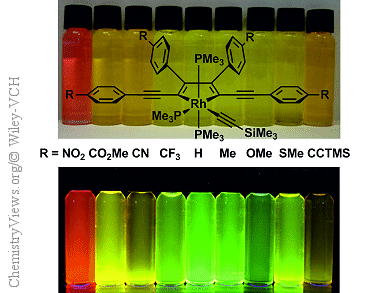Metallacyclopentadienes are used in a variety of applications, including as catalysts, as photosensitizers for dye-sensitized solar cells, and as luminescent materials for organic light-emitting diodes (OLEDs). Synthetic access to conjugated 2,5-bis(R-ethynyl)metallacyclopentadienes should, in principle, be possible by reductive coupling of 1,3-butadiynes at a suitable transition-metal precursor complex. However, examples of such a coupling are scarce, and most of the reactions do not occur with the desired regioselectivity.
Todd Marder, Julius Maximilians-Universität Würzburg, Germany, and colleagues have shown that reductive coupling of 1,4-bis(p-R-arylethynyl)-1,3-butadiynes is a general synthetic approach to rhodacyclopentadienes. They have used this method to create a series of 2,5-bis(arylethynyl)rhodacyclopentadienes with a variety of substituents of differing electronic donor or acceptor strength and different ligand combinations at the Rh center. The reactions occur regiospecifically, yielding the 2,5-isomer exclusively.
The photophysical properties of the rhodacyclopentadienes are highly unusual in that they exhibit, exclusively, fluorescence between 500–800 nm from the S1 state, with low to moderate quantum yields (Φ = 0.01–0.18) and short lifetimes (τ = 0.45–8.20 ns). The triplet state formation is exceptionally slow, occurring on the nanosecond timescale. This is unexpected, because the Rh atom should normally facilitate intersystem crossing within femto- to picoseconds, leading to phosphorescence from the T1 state.
This work highlights that in some transition-metal complexes the heavy atom can play a more subtle role in controlling the photophysical behavior than is commonly appreciated.
- Regiospecific Formation and Unusual Optical Properties of 2,5-Bis(arylethynyl)rhodacyclopentadienes: A New Class of Luminescent Organometallics,
Andreas Steffen, Richard Ward, Meng Guan Tay, Robert Edkins, Fabian Seeler, Magda van Leeuwen, Lars-Olof Pålsson, Andrew Beeby, Andrei Batsanov, Judith Howard, Todd Marder,
Chem. Eur. J. 2014.
DOI: 10.1002/chem.201304068




